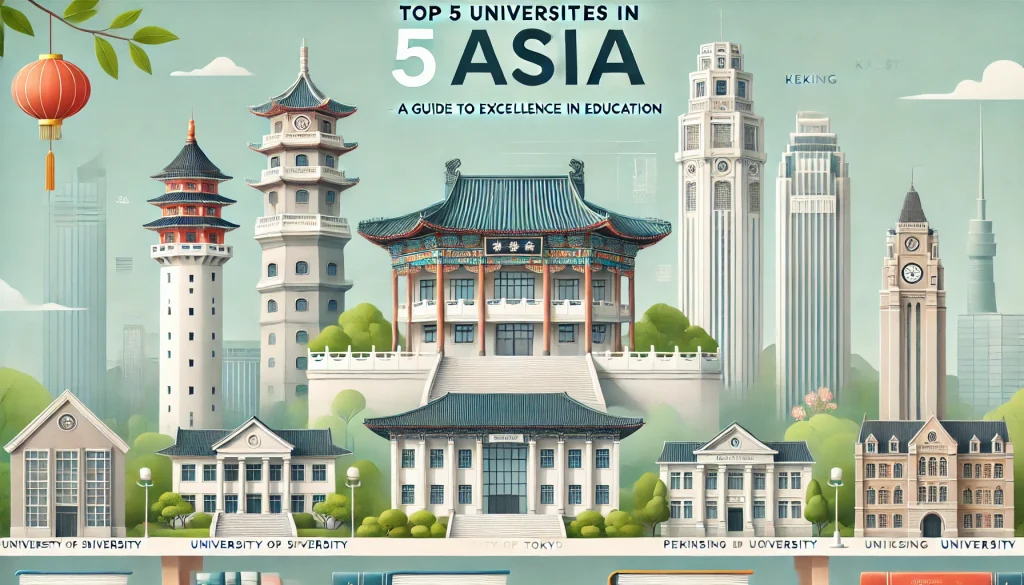Top 5 Universities in Asia (2025)

Asia’s top universities have gained global recognition for their high academic standards, strong research programs, and modern facilities. Here’s an in-depth look at the top five universities based on the latest QS Asia University Rankings.
1. National University of Singapore (NUS)
Overview: NUS is consistently one of Asia’s top-ranked universities, known for its rigorous academic environment and interdisciplinary research. The university has a rich history of excellence, particularly in engineering, life sciences, and social sciences.
Courses: Popular fields of study include Computer Science, Business, Engineering, and Medicine. NUS also offers specialized programs in Data Science, Environmental Studies, and Artificial Intelligence.
Tuition: Annual fees for international students range from $15,000 to $50,000 USD, depending on the program. Scholarships and financial aid options are available for eligible students.
Cost of Living: Singapore’s cost of living is high, with estimated expenses (housing, food, and transportation) around $12,000 – $20,000 USD per year.
2. Tsinghua University, China
Overview: Known as China’s leading institution for engineering and technology, Tsinghua University is renowned for its innovation-focused programs and global partnerships. It has a vibrant international community and is highly selective.
Courses: Tsinghua’s strengths lie in Engineering, Computer Science, Architecture, and Public Administration. The university also offers strong programs in Economics and Business through its School of Economics and Management.
Tuition: For international students, tuition ranges from $3,000 to $20,000 USD annually, with some specialized programs costing more.
Cost of Living: Living expenses in Beijing average around $6,000 – $10,000 USD per year, making it more affordable than some other Asian metropolises.
3. University of Tokyo, Japan
Overview: Japan’s most prestigious university, the University of Tokyo, is celebrated for its research output and impact. It is particularly strong in Natural Sciences, Engineering, and Humanities.
Courses: The university offers a broad range of programs, including Engineering, Economics, Medicine, and Law. Interdisciplinary research centers provide additional learning opportunities in advanced scientific fields.
Tuition: International students can expect to pay around $5,000 – $8,000 USD annually, depending on the program.
Cost of Living: Tokyo is one of Asia’s most expensive cities, with estimated living costs of about $12,000 – $18,000 USD per year.
4. Peking University, China
Overview: Peking University is known for its dynamic intellectual environment and cultural heritage. It is widely respected for its programs in Humanities, Social Sciences, and Environmental Science.
Courses: In addition to traditional fields, Peking University offers innovative programs in areas like International Relations, Finance, and Artificial Intelligence.
Tuition: Annual tuition for international students varies by program, generally ranging from $3,500 to $13,000 USD.
Cost of Living: The cost of living in Beijing for students is approximately $6,000 – $10,000 USD annually, covering essentials like accommodation and meals.
5. Korea Advanced Institute of Science and Technology (KAIST), South Korea
Overview: KAIST is South Korea’s top science and technology university, known for groundbreaking research and strong ties with industry. It is highly competitive and attracts many international students.
Courses: KAIST is a leader in Robotics, Artificial Intelligence, Biomedical Engineering, and Business. Its Graduate School of Management offers renowned MBA programs.
Tuition: Tuition fees range from $4,000 to $10,000 USD annually, depending on the degree and program level.
Cost of Living: Students in Daejeon (KAIST’s location) typically spend around $5,000 – $8,000 USD per year on living expenses.
Conclusion
These top Asian universities offer world-class education and cutting-edge research opportunities, preparing students for diverse global careers. While costs and cultures vary widely, these institutions provide excellent academic resources and supportive environments for international students. For prospective students, thorough research and planning can make studying at these prestigious universities both a feasible and rewarding choice.
For more information on the full list of top universities in Asia, check out the QS Asia University Rankings.
Read more about financial aids in the universities



